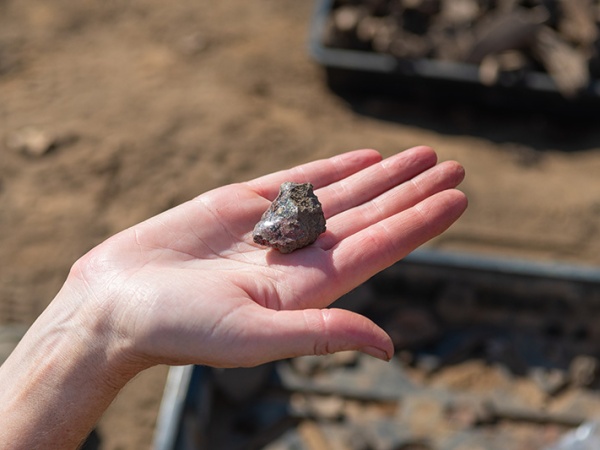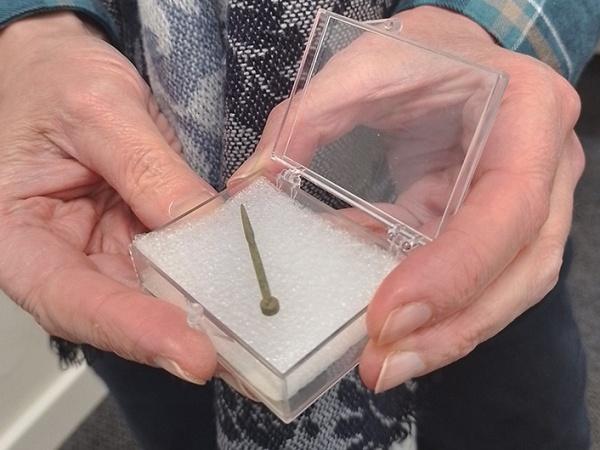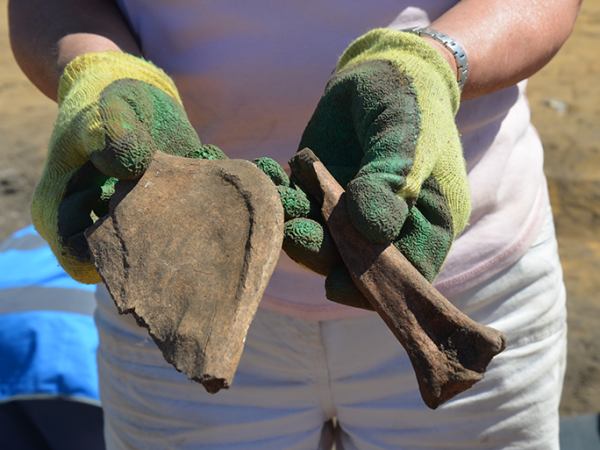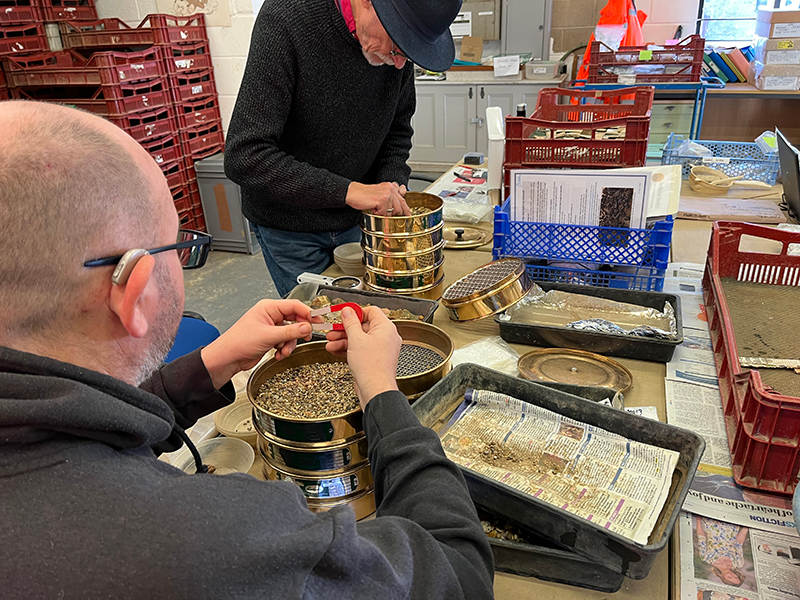Featured image: Glass vessel fragment (SF 129) found in the refuse disposal area excavated in 2022
Dr Rose Broadley is the Rendlesham Revealed project specialist for glass artefacts and has completed the initial analysis of the glass excavated from Rendlesham in 2022 and 2023. Rose is our guest writer this week to tell us more.
Much more early medieval (5th-8th century) glass was found at Rendlesham in 2022 (twenty fragments) than in 2023 (two fragments), largely thanks to the refuse disposal area excavated in 2022, which was where most of the glass was found. Together, the fragments and beads form a diverse and significant group, which can tell us a lot about the site and its people.
The 2022 early medieval glass assemblage contained fragments from glass vessels, glass beads, and arguably most interestingly, window glass fragments. All the window fragments are olive-green or pale green in colour, and all are from the large refuse disposal area. Potentially the most fascinating glass find of the 2022 season is window glass fragment SF 127, which is large by the standard of early medieval glass (I am used to very small fragments!) and almost complete. These early medieval window fragments open the possibility that the hall at Rendlesham may have had some glazed windows, and are important because window glass was rare in the early medieval period and especially so on sites interpreted as secular rather than ecclesiastical. It is difficult to date window glass of this period precisely using typology alone. However, the earliest documentary evidence for window glass in early medieval England dates to the later seventh century (670s CE) and relates to monastic churches at York and Wearmouth. The Rendlesham window glass fragments could be from some of the earliest glazed windows in early medieval England, and are a rare discovery because of their discovery on a royal palace site. The window glass changes our view of how the principal buildings at the Rendlesham royal site may have looked and felt, both from the outside and inside, and provides another indicator of the special nature of the Rendlesham settlement and its residents.

Ten fragments from glass vessels were found in 2022, and one from 2023 (EV 43), which was the star glass find of 2023 despite being small. It is not always possible to definitively identify the original vessel form when working with early medieval vessel glass fragments, especially if they are body fragments rather than rim or base fragments and undecorated. However, EV43 is an example of how a very small fragment can be clearly identified by decoration, colour, fragment morphology and glass quality. This fragment is from a specific type of cone beaker known as ‘Kempston’ cone beakers named after a beaker from a grave at Kempston in Bedfordshire that is now in the British Museum. The Kempston-style cone beakers date from the mid-5th to mid-6th centuries, and are thought to have been used at celebratory and ceremonial occasions as they could not be set down until empty. The Rendlesham cone beaker fragment EV43 is from an interesting context: a fill (3561) of one of a line of post holes (3560), located near the middle of the northern edge of the main trench (Trench 16). The post holes may be the remains of a post-built structure, meaning that this vessel fragment appears to have been found near where it was used (and broken), rather than in a more usual refuse disposal context.
In the case of a second key vessel fragment (SF 129) found in the refuse disposal area in 2022, the deep blue colour, thickness and the quality of the glass are all significant. They suggest an elite vessel of late sixth to seventh century date that may have belonged to a select group of globular beakers found in elite graves and at the royal site at Lyminge, Kent. Most early medieval vessel glass fragments are from beakers or cups used for drinking – identifiable bowls are much less usual, and bottles are extremely rare in this period. Glass jugs, plates and other forms are not known at all. Together, the vessel fragments from Rendlesham provide a tantalising glimpse of drinking, probably associated with feasting, taking place within the settlement.
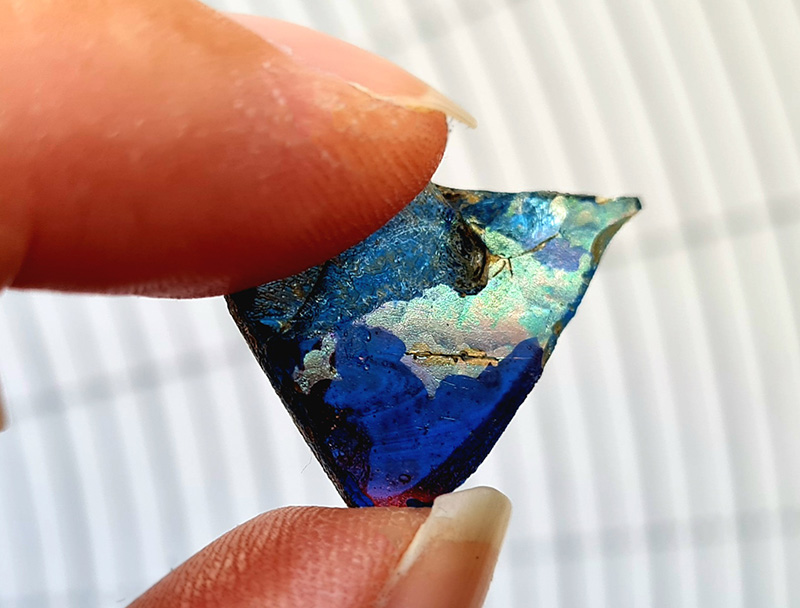
The glass artefact with the most interesting archaeological context from either season is a pale grey-blue Cylinder Round bead (SF 150), that dates from the mid-sixth to mid seventh centuries and was probably imported from continental Europe. This bead is the only glass object to be found within the footprint of the hall excavated in 2022, in the fill of a post hole on the western side, and was probably deposited there accidentally while being worn. Overall, the beads from 2022 are from the sixth to mid-seventh centuries, and feature both likely imports and three that are probably local, suggesting a combination of international and local contact. All are from refuse disposal (secondary deposition) contexts, except for the Cylinder Round bead.

With window glass, vessel fragments and beads present, the glass from Rendlesham informs us about the buildings, some of the activities that took place within them, the jewellery worn by the people there, and the wealth and connections that enabled everything within this community. Hopefully some compositional testing of some of glass and a fragment that might in fact be garnet will be possible in the future. In the meantime, I look forward to the collation, distillation, and communication of all the information from Rendlesham in the final stages of the project.
Find out more
What is involved in post-excavation? Read the first year’s blogs to learn more.
Discover more about the Rendlesham Revealed community fieldwork discoveries.
Learn about the previous archaeological investigations since 2008
This fieldwork is part of the community archaeology project Rendlesham Revealed: Anglo-Saxon Life in South-East Suffolk, funded by the National Lottery Heritage Fund. We are very grateful to our many local and national partners who have made this project possible, and for the support of our volunteers and of the landowners and farmers who work and manage this historic landscape.

